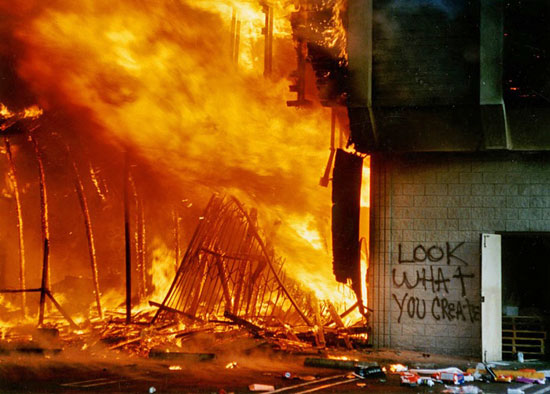Searing lessons of the riots
April 26, 2012
It was several hours after the Rodney King verdicts and the city had yet to exhale. Shocked by the police acquittals, I headed to First AME Church with Mayor Tom Bradley and other civic and religious leaders to urge calm. When we stepped inside, the streets were quiet—which is why I was taken aback a short time later by the pictures of fire and violence on a TV reporter’s monitor inside the church.
“Why are you showing the ’65 Watts Riots?” I asked in a challenging tone.
“Councilman,” he said, “that’s a live shot from our helicopter.”
Within moments, I was being accompanied by a church deacon to my city car, parked near the intersection of Adams and Western. “You cannot walk there yourself,” I was told firmly. By then, every window of the vehicle had been smashed out. I was driven home by an aide to Councilman Nate Holden, who represented the area.
Today, 20 years later, images of those cataclysmic days seem as distant as the Watts Riots did to me on that evening at First AME. There’s almost a grainy, historical look to the photos and videos we’ve seen resurrected in recent days, creating a sense that this dark and transformative moment in our history is long behind us.
Yes, many of the conditions that led to the 1992 explosion of lawlessness have been repaired. One of the most significant events in the aftermath of the riots—the Christopher Commission—has led to a Police Department that is now making headlines for its partnership with minority neighborhoods, not for its hostile disrespect towards them. Today, residents in areas once deprived of the most basic commerce have access to supermarkets and businesses, though still not enough.
And imagine, two decades ago, launching a new transit system through some of the most charred stretches of the region, as we’re doing today with the Expo Line.
So when the question is asked—could it happen again?—many of us, thinking with our hearts, want to say no, of course not. But I think that would be naïve and dangerous. Although police brutality may have been the match that lit the fuse, the riots drew fuel from economic conditions that for years bred deep resentment—conditions that persist today.
We have yet to provide credible hope to those on the lower end of the income scale that they can work their way into the middle class. Employment, affordable housing, health insurance, child care, quality education, all these things and more continue to elude families living in communities enveloped by the 1965 and 1992 riots.
Too often, federal, state and local governments responsible for confronting such issues seem more interested in pointing fingers than in finding solutions. At the minimum, we elected officials must talk with the most marginalized among us and hear the challenges in their lives. The lack of such communication was one key reason the Los Angeles power structure was blindsided by the breadth of the unrest. I know this may sound ridiculously basic, but the fact is that it’s harder to ignore a person’s plight once you’ve had a conversation with them.
Today, from my vantage point on the Board of Supervisors, I can confidently state that our local governments have not shrunk from the challenges brought into harrowing relief by the flames of 20 years ago. We’ve funded neo-natal programs and created school-based health centers to make sure people, especially the youngest amongst us, receive the care they need and deserve. We’ve pushed for a “living wage” for workers at the lowest end of the earning scale. We’ve begun to clean the urban environment and create parks in communities that once offered little more than asphalt. And we’ve embarked upon an ambitious rapid transit agenda that will create thousands of jobs and bring rail transportation to neighborhoods that have gone without it for far too long.
All these share this in common: respect for human dignity. So long as we honor that notion and dedicate ourselves to reducing economic disparities, there is hope we can transform the lives of individuals and communities for the better.
Posted 4/27/12













 405 bridge work causes a stink
405 bridge work causes a stink





